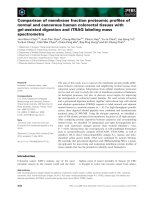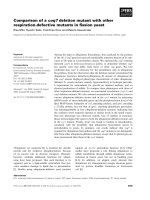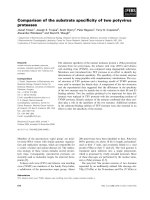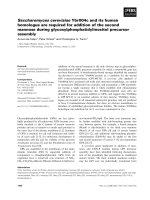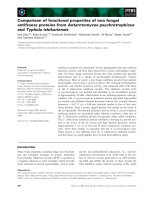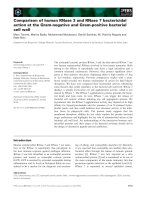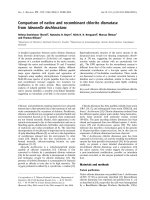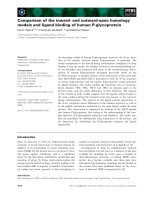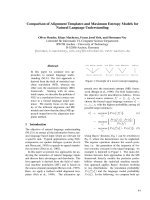Báo cáo khoa học: "Comparison of conformal and intensity modulated radiation therapy techniques for treatment of pelvic tumors. Analysis of acute toxicity" pdf
Bạn đang xem bản rút gọn của tài liệu. Xem và tải ngay bản đầy đủ của tài liệu tại đây (333.6 KB, 7 trang )
RESEARC H Open Access
Comparison of conformal and intensity
modulated radiation therapy techniques for
treatment of pelvic tumors. Analysis of acute
toxicity
Robson Ferrigno
1*
, Adriana Santos
2
, Lidiane C Martins
2
, Eduardo Weltman
1
, Michael J Chen
1
,
Roberto Sakuraba
3
, Cleverson P Lopes
3
, José C Cruz
3
Abstract
Background: This retrospective analysis reports on the comparative outcome of acute gastrointestinal (GI) and
genitourinary (GU) toxicities between conformal radiation therapy (CRT) and intensity modulated radiation therapy
(IMRT) techniques in the treatment of patients with pelvic tumors.
Methods: From January 2002 to December 2008, 69 patients with pelvic tumors underwent whole pelvic CRT and
65 underwent whole pelv ic IMRT to treat pelvic lymph nodes and primary tumor regions. Total dose to the whole
pelvis ranged from 50 to 50.4 Gy in 25 to 28 daily fractions. Chemotherapy (CT) regimen, when employed, was
based upon primary tumor. Acute GI and GU toxic ities were graded by RTOG/EORTC acute radiation morbidity
criteria.
Results: Absence of GI symptoms during radiotherapy (grade 0) was more frequently observed in the IMRT group
(43.1% versus 8.7; p < 0.001) and medication for diarrhea (Grade 2) was more frequently used in the CRT group
(65.2% versus 38.5%; p = 0.002). Acute GI grade 1 and 3 side effects incidence was similar in both groups (18.5%
versus 18.8%; p = 0.95 and 0% versus 7.2%; p = 0.058, respectively). Incidence of GU toxicity was similar in both
groups (grade 0: 61.5% versus 66.6%, p = 0.54; grade 1: 20% versus 8.7%, p = 0.06; grade 2: 18.5% versus 23.5%, p =
0.50 and grade 3: 0% versus 1.5%, p > 0.99).
Conclusions: This comparative case series shows less grade 2 acute GI toxicity in patients treated with whole
pelvic IMRT in comparison with those treated with CRT. Incidence of acute GU toxicity was similar in both groups.
Background
Radiation therapy (RT) plays an important role in the
treatm ent of malignant pelvic tumors, such as endome-
trial, cervical, rectal, vesical, and anal cancers. The use
of the Intensity Modulated Radiation Therapy (IMRT)
for treatment of these tumors has increased in the last
years due to its capacity to decrease the amount of
radiation d ose delivered to the adjacent normal tissues,
such as small bowel, bladder , rectum and bone m arrow.
Therefore, an advantage of this technique may be a
potential benefit to decrease acute and late toxicities.
Gastrointestinal (GI) complications are among the
most common undesirable side effects for patients trea-
ted with whole pelvic RT [1-3]. Diarrhea, a very frequent
symptom, is not only uncomfortable but can also cause
dehydration and nutrients malabsorption [4]. Genitour-
inary (GU) and hematologicalsideeffectsarealsorele-
vant toxicities in the treatment of whole pelvis with RT.
Several dosimetric studies have already shown signifi-
cant reduction of radiation dose delivered to the small
bowel, bladder, rectum, bone marrow and others
organs-at-risk (OAR) with the use of IMRT rather than
conventional or conformal radiotherapy (CRT) [5-15 ].
* Correspondence:
1
Department of Radiation Oncology, Hospital Israelita Albe rt Einstein. Av.
Albert Einstein, 627, São Paulo - SP - 05651-901 - Brazil
Full list of author information is available at the end of the article
Ferrigno et al . Radiation Oncology 2010, 5:117
/>© 2010 Ferrigno et al; licensee BioMed Central Ltd. This is an Ope n Access article distributed under the terms of the Creative
Commons Attribution License ( enses/by/2.0), which permits unrestricted use, distribution, and
reproduction in any medium, provided the original work is properly cited.
IMRT dosimetric characteristics provide a strong poten-
tial to reduce both acute and chronic RT toxicities. Pub-
lished clinical outcomes with pelvic IMRT report
reduced GI, GU and hematological toxiciti es when com-
pared with conventional or CRT techniques but most of
these studies are comparative case series or retrospective
analyses with a small number of patients or with consid-
erable heterogeneity [16-25].
This retrospective and comparative case series aimed
to report results of acute GI and GU toxicities in
patients with pelvic tumors treated with CRT versus
IMRTtechniques.Thisisthefirstclinicalreporton
IMRT from South America. All other series are from
United States of America (USA) and Europe.
Methods
Patients
We retrospectively compared 69 patients with pelvic
tumors treated by whole pelvic CRT with 65 treated by
whole pelvic IMRT, to evaluate the incidence and sever-
ity of acute GI and GU toxicities during the treatment.
No patient had any symptom or morbidity before the
RT treatment. Patients from both groups were treated
between January 2002 and December 2008 in the
Department of Radiation Oncology at the Ho spital
Israelita Albert Einstein, in São Paulo. Primary tumor
sites included endometrium, cervix, rectum a nd anal
canal in the CRT group and endometrium, cervix,
rectum, anal canal and bladder in the IMRT group.
Table 1 summarizes patients’ characteristics of both
groups.
Radiotherapy
Patients from both groups were treated by whole pelvic
RT following the International Commission on Radia-
tion Units and Measurements (ICRU) No. 50 recom-
mendations [26]. The clinical target volume (CTV) was
defined as pelvic lymph nodes and primary tumor
region and was contoured on individual axial CT slices.
The lymph node regions were determined by encom-
passing the blood vessels with a 2 cm margin and based
upon primary tumor site. The planning target volume
(PTV) was created expanding the CTV by 1 cm. The
small bowel region was defined by contouring t he peri-
toneal cavity from the L4 lev el and excluding the rec-
tum, bladder and blood vessels. The dose prescribed, to
encompass at least 95% of the PTV, r anged from 45 to
50.4 Gy, delivered in 25 to 28 daily fractions in the
phase of elect ive pelvic lymph node treatment. Treat-
ment plannings were generated using the Eclipse Helios
software (Varian M edical Systems, Palo Alto, CA) for
CRT and IMRT. Dose volume restrictions used for
OARs in both groups are described in Table 2.
In the CRT group, plans were based on 3 or 4 pelvic
isocentric conformed coplanar fields with energy of 18-
MV and patients were treated with a Varian CL2100 C
linear accelerator (Varian Medical Systems, Palo Alto,
CA) equipped with 80-leaf multileaf collimator, while in
the I MRT group, treatment plannings were based upon
a dynamic technique ("sliding window” ), using 5 to 9
isocentric coplanar fields, equally spaced, with energy of
15-MV and patients were treated with Varian CL2300
EX linear accelerator (Varian Medical Systems, Palo
Alto, CA) equipped with 120-leaf multileaf collimator.
Chemotherapy
Chemotherapy (CT), when employed, was based on pri-
mary tumor site. In both groups, the proportion of
patients treated with CRT during the course of RT was
Table 1 Characteristics of IMRT and CRT patients
Characteristic IMRT CRT P value
Patient number 65 69 0,53*
Age (y)
Median 62 64 0.75*
Range 35 – 96 28 – 88
Tumor site
Endometrium 17 (26.1%) 20 (29%)
Cervix 8 (12.3%) 3 (4.3%) <0.001
Rectum 21 (32.3%) 40 (58%)
Anal Canal 7 (10.8%) 6 (8.7%)
Bladder 12 (18.5%) 0
RT goal
Adjuvant 29 39 0.004
Neo-adjuvant 14 23
Definitive 22 7
Gender
Female 44 39 0.18
Male 21 30
Chemotherapy 0.42
Yes 39 46
No 26 23
* Student t test
Table 2 Dose volume restrictions for pelvic OARs used in
Hospital Israelita Albert Einstein
OAR DOSE VOLUME RESTRICTIONS
RECTUM ≤ 55%: ≥ 47 Gy ≤ 40%: ≥ 65 Gy
≤ 25%: ≥ 70 Gy ≤ 10%: ≥ 75 Gy
Dmax: 82 Gy
SMALL BOWEL ≤ 100%: ≥ 40 Gy ≤ 66%: ≥ 45 Gy
≤ 33%: ≥ 50 Gy
Dmax: 60 Gy
BLADDER ≤ 55%: ≥ 47 Gy ≤ 30%: ≥ 70 Gy
Dmax: 82 Gy
FEMORAL HEAD Dmax: 50 Gy
Dmax: Maximum point dose.
Ferrigno et al . Radiation Oncology 2010, 5:117
/>Page 2 of 7
equally balanced (Table 1). No patient with endome-
trium cancer was treated with CT, patients with cervix
cancer, when treated with concomitant CT and RT,
received weekly Cisplatin (40 mg/m
2
). Those with rectal
cancer received oral daily Capecitabine (825 mg/m
2
BID, 5 days/week), those with anal canal cancer received
5-Flourouracil (1000 mg/m
2
continuous infusion days 1
- 4) and Mitomycin-C (10 mg/m
2
on day 1) during the
first and last week of RT, and those with bladder cancer
received weekly Cisplatin (40 mg/m
2
).
In the CRT group the proportion of patients who
underwent CT according to the primary tumor site was:
endometrium: 0/20 (0%); cervix: 1/3 (33%); rectum: 39/
40 (98%) and anal canal: 6/6 (100%), while in the IMRT
group the proportion was: endometrium: 0/17 (0%); cer-
vix: 4/8 (50%); rectum: 18/21 (86%); anal canal: 7/7
(100%) and bladder: 9/11 (82%).
Analysis of Acute toxicity
All patients were evaluated weekly for acute GI and GU
toxiciti es during the RT. Symptoms and tr eatment were
recorded on the chart. We retrospectively reviewed
these charts and graded acute GI and GU toxicities by
the RTOG/EORTC acute radiation morbidity criteria
[27]. Patients with rectal cancer were analyzed
separately.
Statistical analysis
All statistical analyses were pe rformed with a statistical
softwar e STATA Statistics/Data analysis (STATA Corp.
2001 Stata Statistical Software: Rele ase 7.0 College Sta-
tion, TX: Stata Corporation). The primary endpoints to
be compared between both groups were incidence and
severity of acute GI and GU toxicities during RT. The
Chi-square frequencies test was used to verify the asso-
ciation between categorical variables and contingency
tables. The Fisher’s exact test was adopted in tables 2 ×
2 when at least one expected frequency was lower than
5. The Student’s t test was applied to verify association
of numerical variables between the CRT and IMRT
groups. A 5% significance level was considered for all
statistical analyses.
Results
The characteristi cs of CRT and IMRT patients are sum-
marized in Table 1. All but tumor site distribution and
RT goal are equally balanced in both groups.
The crude incidence of grade 2 acute GI (medication
for diarrhea) was more frequent in t he CRT group
(65,2% Vs 38,5%; p < 0.001) and absence of any GI
symptoms (grade 0) was more frequently observed
among patients treated with the IMRT technique (82.4 %
Vs 17.6%; p < 0.001). Table 3 shows the crude incidence
of acute GI toxicity according to RTOG/EORTC grading
criteria.
The crude incidence of acute GU complications was
statistically similar in bothgroups(Table4).Urinary
symptoms not requiring medication (grade 1) were mar-
ginally more frequent among patients treated with
IMRT (20% Vs 8.7%, p = 0.06).
Patients with rectal cancer treated with IMRT pre-
sented a lower incidence of acute grade 2 (medication
for diarrhea) GI toxicities (9.5% Vs 65%; p <0.01).
Absence of any symptom (grade 0) was more frequently
found i n patients treated with IMRT (23.8% Vs 5%; p =
0.077). Acute grade 1 GI toxicity was more frequent in
patients from th e IMRT group (66.6% Vs 20%; p < 0.01)
(Table 5). Crude incidence of acute GU toxicity was
similar in both groups among patients with rectal cancer
(Table 6).
Discussion
Use of IMRT in the treatment of pelvic tumors has been
increasing throughout the world for more than a decade.
Our results of acute toxicity among patients in the
IMRT group wer e presented at the 2009 Annual
ASTRO meeting [28]. Many publications discuss the
theoretical advantages of IMRT dose distribution and
two complete revisions about its use in gynecological
cancers have already been published [29,30]. Further-
more, there are several dosimetric studies that show
reduction of dose delivered to the pelvic OARs with
IMRT when compared with conventional or CRT tech-
niques in the treatment of gynecological cancers
[6-8,10,14,15], rectal cancer [5,11], anal canal cancer
[9,13] and bladder cancer [12]. However, the main
Table 3 Crude incidence of acute GI toxicity in both
groups according to RTOG/EORTC acute radiation
morbidity criteria
Grade IMRT group (n = 65) CRT group (n = 69) P value
0 28 (43.1%) 6 (8.7%) <0.001
1 12 (18.5%) 13 (18.8%) 0.955
2 25 (38.5%) 45 (65.2%) 0.002
3 0 (0%) 5 (7.2%) 0.058*
*Fisher’s exact test
Table 4 Crude incidence of acute GU toxicity in both
groups according to RTOG/EORTC acute radiation
morbidity criteria
Grade IMRT group (n = 65) CRT group (n = 69) P value
0 40 (61.5%) 46 (66.6%) 0.54
1 13 (20%) 6 (8.7%) 0.06
2 12 (18.5%) 16 (23.5%) 0.50
3 0 (0%) 1 (1.5%) >0.99*
*Fisher’s exact test
Ferrigno et al . Radiation Oncology 2010, 5:117
/>Page 3 of 7
question is whether the dosimetric advantages of IMRT
can lead to clinically relevant results when compared
with non-modulated external beam RT.
Veldeman et al [31] made a systematic review of 41
comparative clinical studies with the use of IMRT that
reported on overall survival, disease-specific survival,
quality of life and/or treatment-induced toxicity, pub-
lished prior to August 21, 2007. Concerning pelvic
tumors, the authors did not find any prospective study
that compares IMRT with non-IMRT technique.
Furthermore, no study about overall survival, disease-
specific survival or quality o f life had been published
until then. These authors identified three comparative
case series for gynecological malignancies that signifi-
cantly showed lower rates of acute GI toxicity
[16,17,24], one with less chronic GI toxicity [18], one
with less hematological side effects [23] and one with
lower acute GU toxicities [24] in patients treated by pel-
vic IMRT in comparison to those treated by non-IMRT
techniques. For anal canal cancer, they included just one
non-comparative case series with 17 patients that
showed no grade 3 or higher acute non-hematological
toxic effects or treatment breaks attributable to GI or
skin toxicity [9].
Other c linical studies have also been published about
use of IMRT in gynecological cancers [19,20,22], and
[25], in rectal cancer [21] and in bladder cancer [12]. All
these studies showed a lower rate of radiation-inducti on
toxicity with IMRT.
Considering evidence-based medicine, multi-institu-
tional prospective clinical trials are important to corro-
borate the real benefit of IMRT in the treatment of
pelvic t umors. The Radiation Therapy Oncology Group
(RTOG) is conducting a prospective phase II study of
IMRT for postoperative patients with either end ometrial
or cervical carcinoma with or without chemotherapy
(RTOG 0418) and the Tata Memorial Hospital, in
Mumbai, India, is conducting the only ongoing prospec-
tive phase II randomized trial comparing conventional
RT versus IMRT in the treatment of cervical cancer.
Results of these two trials will contribute to assess the
benefits and risks of IMRT in patients with gynecologic
tumors.
The most important result from our series was the
lower incidence of medication for diarrhea (grade 2)
among patients treate d with IMRT. Diarrhea is a very
uncomfortable symptom and can cause dehydration and
malabsorption of vitamins, lactose, and bile acids [4].
Another important finding was the higher absence of GI
symptoms (grade 0) in IMRT group (43.1% versus 8.7%;
p < 0.001). The possibility of offering a greater opportu-
nity to avoid GI symptoms to pat ients under RT treat-
ment is a considerable advantage for IMRT. Because use
of CT is now well established for treatment of some pel-
vic tumors sites, such as t he rectum, cervix, anal canal
and bladder, IMRT can be very useful to reduce the
acute toxicities potentialized by CT since it not only
improves delivery of CT b ut also potentially provides
conditions for CT dose escalation.
In our series, use of IMRT did not reduce a cute GU
toxicities. The incidence of acute grade 1 GU side
effects was marginally more frequent in the IMRT
group (20% versus 8.7%; p = 0.06) as shown in table 4.
As grade 1 acute GU r adiation morbidity is defined by
RTOG/EORTC criteria as “Frequency of urination or
nocturia twice pretreatment habit and dysuria or
urgency not requiring medication” [27], this difference is
not important in clinical practice and definition of this
grade could be subjective, as the information collected
was based on physician’s notes in patient’s charts.
Our results of lower acute GI toxicity in the IMRT
group and similar acute GU toxicity in both groups
were like those reported by the Mundt et al. [17]
through a comparative case series for women with gyne-
cological malignancies. They reported on grade 2 acute
GI toxicity less common in the IMRT group than in the
conventional RT (60% vs. 91%; p =0.002)andgrade2
GU toxicity not statistically significant (10% vs. 20%; p =
0.22).
Due to the relatively greater number of patients with
rectal cancer in the CRT group and that almost all had
been treated by combined CT with capecitabine (98% in
theCRTgroupand86%intheIMRTgroup),weper-
formed a separa te analysis of these patients. Absence of
GI symptoms (grade 0) was greater in IMRT group
(23.8% versus 5%; p =0.07),asshownintable5.
Table 5 Crude incidence of acute GI toxicity in both
groups according to RTOG/EORTC acute radiation
morbidity criteria in patients with rectal cancer
Grade IMRT group (n = 21) CRT group (n = 40) P value
0 5 (23.8%) 2 (5%) 0.077
1 14 (66.6%) 8 (20%) <0.001
2 2 (9.5%) 26 (65%) <0.001
3 0 (0%) 4 (10%) 0.339*
*Fisher’s exact test
Table 6 Crude incidence of acute GU toxicity in both
groups according to RTOG/EORTC acute radiation
morbidity criteria in patients with rectal cancer
Grade IMRT group (n = 21) CRT group (n = 40) P value
0 18 (85.7%) 26 (65%) 0.086
1 2 (9.5%) 4 (10%) 0.694
2 1 (4.8%) 9 (22.5%) 0.157
3 0 (0%) 1 (1.5%) > 0.99*
*Fisher’s exact test
Ferrigno et al . Radiation Oncology 2010, 5:117
/>Page 4 of 7
Medication for diarrhea (grade 2) was significantly lower
in the IMRT group (9.5% versus 65%; p < 0.001). Con-
sidering that capecitabine alone can also cause diarrhea
and increase radiosensitivity, this finding is considerably
positive in favor of I MRT. Curiously, grade 1 acute GI
toxicity was more often found among patients treated
by IMRT. Because grade 1 acute GI side effects are
described by RTOG/EORTC criteria as “increased fre-
quency or change in qualit y of bowel habit s nor requi r-
ing medication or rectal discomfort not requiring
analgesics” [27], this finding is not relevant in the clini-
cal practice and these symptoms are a subjective
endpoint.
No difference was observed in crude incidence of
acute GU toxicity in patients with rectal cancer treated
with CRT or IMRT technique (Table 6) as we also
observed when all patients with other primary tumor
sites are considered (Table 4). These findings suggest
that the bladder is less sensitive to reductions in volume
irradiated than the small bowel, especially when the
total dose is up to 50 Gy. We also must consider that
the low number of events could have limited the statisti-
cal power of this analysis.
Another advantage of IMRT is the possibility to deli-
ver a different level of daily dose to the distinct target
volumes. In our Institution, we routinely treat patients
with rectal cancer with preoperative RT concomitant
to CT and due to the lesser prob ability of small bowel
toxicity with IMRT, all patients are nowadays treated
with this technique using synchronous integrated boost
(SIB) strategy to deliver 50 Gy (2 Gy/fraction) to the
gross primary tumor while simultaneously delivering
45 Gy (1.8 Gy/fraction) to the regional lymph nodes
and areas of risk for harboring microscopic disease
(Figure1).ThereisoneongoingprospectivefaseII
trial using preoperative SIB-IMRT strategy and capeci-
tabine for treatment of locally advanced re ctal cancer
[21]. In this study, a total dose of 55 Gy (2.2 Gy/frac-
tions) is delivered to the primary tumor and of 45 Gy
(1.8 Gy/fractions) to the lymph nodes regions in 25
fractions. The preliminary results already published,
with only eight patients showed an impressive patholo-
gic complete respo nse rate of 38% with minimal toxi-
city. T hese results warrant fu rther evaluation in future
larger cooperative and prospective phase II or phase III
trials.
In conclusion, this retrospective and comparative case
series showed that use of the IMRT technique to treat
pelvic tumors reduced the frequency and severity of GI
symptoms and the need of medication for diarrhea in
comparison to the CRT technique, but did not reduce
incidence of acute GU toxicities. For rectal cancer
patients these benefits were also observed, even with
concomitant CT. For these reasons, the IMRT techni-
que, when available, should be considered to treat pelvi c
tumors whenever the lymph nodes and primary tumor
sites must be irradiated.
List of abbreviation
ASTRO: Americal Society of Therapeutic Radiation Oncology; CRT: Conformal
Radiation Therapy; CT: Chemotherapy; CTV: Clinical Target Volume; EORTC:
European Organization on Radiation Therapy Consortium; GI: Gastrointestinal;
GU: Genitourinary; ICRU: International Comission on Radiation Unit and
Mensurements; IMRT: Intensity Modulated Radiation Therapy; OAR: Organ at
Risk; PTV: Planning Target Volume; RT: Radiation Therapy; RTOG: Radiation
Therapy Oncology Group; SIB: Simultaneous Integrated Boost;
50Gy
45Gy
45G
50G
y
Figure 1 Dose distributions with SIB-IMRT strategy at lymph node regions and primary tumor site in a patient with low rectal cancer,
to receive 45 Gy (blue painting) and 50 Gy (orange painting), respectively, in 25 daily fractions.
Ferrigno et al . Radiation Oncology 2010, 5:117
/>Page 5 of 7
Author details
1
Department of Radiation Oncology, Hospital Israelita Albe rt Einstein. Av.
Albert Einstein, 627, São Paulo - SP - 05651-901 - Brazil.
2
Service of
Dosimetry, Hospital Israelita Albert Einstein. Av. Albert Einstein, 627, São
Paulo - SP - 05651-901 - Brazil.
3
Department of Medical Physics, Hospital
Israelita Albert Einstein. Av. Albert Einstein, 627, São Paulo - SP - 05651-901 -
Brazil.
Authors’ contributions
RF carried out the patients’ data from their charts and wrote the manuscript.
AS separated and organized the patient’s charts.
LCM helped to verify the literature data about IMRT.
EW participated in the identification and classification of acute
gastrointestinal toxicities.
MJC participated in the identification and classification of acute
gentitourinary toxicities.
RS performed the statistical analysis.
CPL helped the statistical analysis calculation.
JCC participated in the figures configuration and helped to write the
manuscript.
All authors read and approved the final manuscript.
Competing interests
The authors of the present manuscript (R Ferrigno, A Santos, LC Martins, E
Weltman, M Chen, R Sakuraba, CP Lopes, VD Gonçalves, and JC da Cruz)
declare that they have no competing interests.
Received: 21 September 2010 Accepted: 14 December 2010
Published: 14 December 2010
References
1. Perez CA, Breaux S, Bedwinek JM, et al: Radiation therapy alone in the
treatment of carcinoma of the uterine cervix. II. Analysis of
complications. Cancer 1984, 54:235-356.
2. Roeske JC, Mundt AJ, Halpern H, et al: Late rectal sequelae following
definitive radiation therapy for carcinoma of the uterine cervix: A
dosimetric analysis. Int J Radiat Oncol Biol Phys 1997, 37:351-358.
3. Corn BW, Lanciano RM, Greven KM, et al: Impact of improved irradiation
technique, age, and lymph node sampling on the severe complication
rate of surgically staged endometrial cancer patients. A multivariate
analysis. J Clin Oncol 1994, 12:510-515.
4. Snijders-Keiholz A, Griffioen G, Davelaar J, et al: Vitamin B
12
malabsortion
after irradiation for gynaecological tumors. Anticancer Res 1993,
13:1877-1881.
5. Urbano MTG, Henrys AJ, Adams EJ, et al: Intensity-modulated radiotherapy
in patients with locally advanced rectal cancer reduces volume of bowel
treated to high dose levels. Int J Radiat Oncol Biol Phys 2006, 65:907-916.
6. Roeske JC, Lujan A, Rotmensch J, et al: Intensity-modulated whole pelvic
radiation therapy in patients with gynecologic malignancies. Int J Radiat
Oncol Biol Phys 2000, 48:1613-1621.
7. Ahamad A, D’Souza W, Salehpour M, et al: Intensity-modulated radiation
therapy after hysterectomy: comparison with conventional treatment
and sensitivity of the normal-tissue-sparing effect to margin size. Int J
Radiat Oncol Biol Phys 2005, 62:1117-1124.
8. D’Souza WD, Ahamad AA, Iyer RB, et al: Feasibility of dose escalation
using intensity-modulated radiotherapy in posthysterectomy cervical
carcinoma. Int J Radiat Oncol Biol Phys 2005, 61:1062-1070.
9. Milano MT, Jani AB, Farrey KJ, et al: Intensity-modulated radiation therapy
(IMRT) in the treatment of anal cancer: toxicity and clinical outcome. Int
J Radiat Oncol Biol Phys 2005, 63:354-361.
10. Chan P, Yeo I, Perkins G, et al: Dosimetric comparison of intensity-
modulated, conformal, and four-field pelvic radiotherapy boost plans for
gynecologic cancer: a retrospective planning study. Radiat Oncol 2006,
4:13-21.
11. Engels B, De Ridder M, Tournel K, et al: Preoperative helical tomotherapy
and megavoltage computed tomography for rectal cancer: impact on
the irradiated volume of small bowel. Int J Radiat Oncol Biol Phys 2009,
74:1476-1480.
12. Sondergaard J, Hoyer M, Petersen JB, et al: The normal tissue sparing
obtained with simultaneous treatment of pelvic lymph node and
bladder using intensity-modulated radiotherapy. Int J Radiat Oncol Biol
Phys 2009, 48:238-244.
13. Menkarios C, Azria D, Laliberté B, et al: Optimal organ-sparing intensity-
modulated radiation therapy (IMRT) regimen for the treatment of locally
advanced anal canal carcinoma: a comparison of conventional and IMRT
plans. Radiat Oncol 2007, 15:41-49.
14. Mell LK, Tiryaki H, Ahn KH, et al
: Dosimetric comparison of bone marrow-
sparing intensity-modulated radiotherapy versus conventional
techniques for treatment of cervical cancer. Int J Radiat Oncol Biol Phys
2008, 71:1504-1510.
15. Lujan AE, Mundt AJ, Yamada SD, et al: Intensity-modulated radiotherapy
as a means of reducing dose to bone marrow in gynecologic patients
receiving whole pelvic radiotherapy. Mell LK, Tiryaki H, Ahn KH, et al.
Dosimetric comparison of bone marrow-sparing intensity-modulated
radiotherapy versus conventional techniques for treatment of cervical
cancer. Int J Radiat Oncol Biol Phys 2003, 57:516-521.
16. Mundt AJ, Roeske JC, Lujan AE, et al: Initial clinical experience with
intensity-modulated whole-pelvis radiation therapy in women with
gynecologic malignancies. Gynecol Oncol 2001, 82:456-563.
17. Mundt AJ, Lujan AE, Rotmensch J, et al: Intensity-modulated whole pelvic
radiotherapy in women with gynecologic malignancies. Int J Radiat Oncol
Biol Phys 2002, 52:1330-1337.
18. Mundt AJ, Mell LK, Roeske JC: Preliminary analysis of chronic
gastrointestinal toxicity in gynecologic patients treated with intensity-
modulated whole pelvic radiation therapy. Int J Radiat Oncol Biol Phys
2003, 56:1354-1360.
19. Beriwal S, Heron DE, Kim H, et al: Intensity-modulated radiotherapy for
the treatment of vulvar carcinoma: a comparative dosimetric study with
early clinical outcome. Int J Radiat Oncol Biol Phys 2006, 64:1395-1400.
20. Beriwal S, Jain Sk, Heron DE, et al: Clinical outcome with adjuvant
treatment of endometrial carcinoma using intensity-modulated radiation
therapy. Gynecol Oncol 2006, 102:195-199.
21. Ballonoff A, Kavanagh B, McCarter M, et al: Preoperative capecitabine and
accelerated intensity-modulated radiotherapy in locally advanced rectal
cancer: a phase II trial. Am J Clin Oncol 2008, 31:264-270.
22. Tierney RM, Powell MA, Mutch DG, et al: Acute toxicity of postoperative
IMRT and chemotherapy for endometrial cancer. Radiat Med 2007,
25:439-445.
23. Chen MF, Tseng CJ, Kuo YC, et al: Clinical outcome in posthysterectomy
cervical cancer patients treated with concurrent cisplatin and intensity-
modulated pelvic radiotherapy: comparison with conventional
radiotherapy. Int J Radiat Oncol Biol Phys 2007, 67:1438-1444.
24. Brixey CJ, Roeske JC, Lujan AE, et al: Impact of intensity-modulated
radiotherapy on acute hematological toxicity in women with
gynecologic malignancies. Int J Radiat Oncol Biol Phys 2002, 54:1388-1396.
25. Mell LK, Kochanski JD, Roeske JC: Dosimetric predictors of acute
hematologic toxicity in cervical cancer patients treated with concurrent
cisplatin and intensity-modulated pelvic radiotherapy. Int J Radiat Oncol
Biol Phys 2006, 66:1356-1365.
26. International Commission on Radiation Units and Measurements (ICRU):
Report Number 50: Prescribing, recording, and reporting photon beam
therapy. Washington, DC: ICRU; 1993.
27. Cox JF, Stetz J, Pajak TF: Toxicity criteria of the Radiation Therapy
Oncology Group (RTOG) and the European Organization for Research
and Treatment of Cancer (EORTC). Int J Radiat Oncol Biol Phys 1995,
31:1341-1346.
28. Ferrigno R, Santos A, Weltman E, et al: Elective radiotherapy with intensity
modulated radiation therapy (IMRT) technique in the treatment of pelvic
lymph nodes and primary tumor region. Analysis of acute toxicity.
Procedings of the 49th ASTRO Annual Meeting Chicago, IL; 2009, Abstract
number 1109.
29. Randall ME, Ibbott GS: Intensity-modulated radiation therapy for
gynecologic cancers: Pitfall, hazards, and cautions to be considered.
Semin Radiat Oncol 2006, 16:138-143.
30. Jhingran A: Potential advantages of intensity-modulated radiation
therapy in gynecologic malignancies. Semin Radiat Oncol 2006,
16:144-151.
Ferrigno et al . Radiation Oncology 2010, 5:117
/>Page 6 of 7
31. Veldeman L, Madani I, Hulstaert F, et al: Evidence behind use of intensity-
modulated radiotherapy: a systematic review of comparative clinical
studies. Lancet Oncol 2008, 9:367-375.
doi:10.1186/1748-717X-5-117
Cite this article as: Ferrigno et al .: Comparison of conformal and
intensity modulated radiation therapy techniques for treatment of
pelvic tumors. Analysis of acute toxicity. Radiation Oncology 2010 5:117.
Submit your next manuscript to BioMed Central
and take full advantage of:
• Convenient online submission
• Thorough peer review
• No space constraints or color figure charges
• Immediate publication on acceptance
• Inclusion in PubMed, CAS, Scopus and Google Scholar
• Research which is freely available for redistribution
Submit your manuscript at
www.biomedcentral.com/submit
Ferrigno et al . Radiation Oncology 2010, 5:117
/>Page 7 of 7
